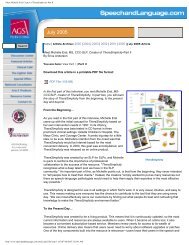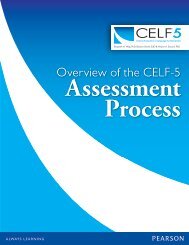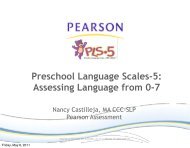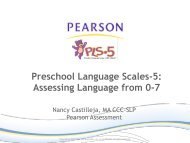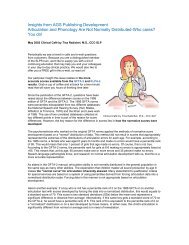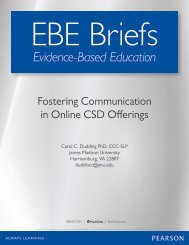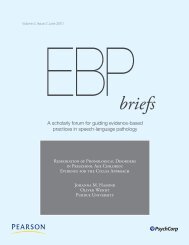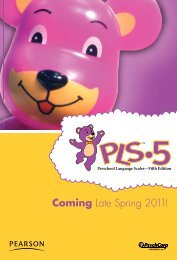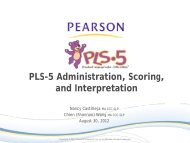Determining the Severity of a Language Disorder - Speech and ...
Determining the Severity of a Language Disorder - Speech and ...
Determining the Severity of a Language Disorder - Speech and ...
Create successful ePaper yourself
Turn your PDF publications into a flip-book with our unique Google optimized e-Paper software.
Elisabeth H. Wiig, PhD, Eleanor Semel, EdD & Wayne A. Secord, PhD<br />
<strong>Determining</strong><br />
<strong>the</strong> <strong>Severity</strong> <strong>of</strong> a<br />
<strong>Language</strong><br />
<strong>Disorder</strong>
<strong>Determining</strong> <strong>the</strong> <strong>Severity</strong> <strong>of</strong> a <strong>Language</strong> <strong>Disorder</strong><br />
<strong>Severity</strong> Guidelines<br />
Individual Test Scores<br />
CELF-5 test scaled scores provide a measure <strong>of</strong> specific aspects<br />
<strong>of</strong> language form <strong>and</strong> content, depending on <strong>the</strong> test task <strong>and</strong><br />
student’s response. Test scaled scores are used to compare <strong>the</strong><br />
student’s performance to <strong>the</strong> typical performances <strong>of</strong> <strong>the</strong> sameage<br />
norm group. These scores are derived from <strong>the</strong> total raw<br />
scores for each test <strong>and</strong> are on a normalized score scale that has<br />
a mean <strong>of</strong> 10 <strong>and</strong> a st<strong>and</strong>ard deviation (SD) <strong>of</strong> 3. A scaled score<br />
<strong>of</strong> 10 describes <strong>the</strong> average <strong>of</strong> a given age group. Scores <strong>of</strong> 7<br />
<strong>and</strong> 13 are 1 SD below <strong>and</strong> above <strong>the</strong> mean, respectively. About<br />
two-thirds <strong>of</strong> all students with typical language development earn<br />
scaled scores between 7 <strong>and</strong> 13 (scaled scores <strong>of</strong> 8–12), <strong>the</strong> range<br />
<strong>of</strong> average performance. Table 4.1 shows <strong>the</strong> relationship <strong>of</strong><br />
CELF-5 scaled scores <strong>and</strong> percentile ranks to distances from <strong>the</strong><br />
mean, expressed in SD units. Use <strong>the</strong> norms tables in Appendix<br />
C to convert <strong>the</strong> raw score for each test to a normalized<br />
scaled score.<br />
Table 4.1 Distances From <strong>the</strong> Mean <strong>of</strong> Test Scaled Scores<br />
Scaled Score Distance From Mean Percentile Rank<br />
19 +3 SD 99.9<br />
16 +2 SD 98<br />
13 +1 SD 84<br />
10 Mean 50<br />
7 –1 SD 16<br />
4 –2 SD 2<br />
1 –3 SD 0.1<br />
Table 4.2 Guidelines to Describe Performance<br />
Using Scaled Scores<br />
Test Score<br />
Scaled Classification Relationship to Mean<br />
13 <strong>and</strong> above Above average + 1 SD <strong>and</strong> above<br />
8 to 12 Average Within + or – 1 SD<br />
7 <strong>and</strong> below Below average –1 SD <strong>and</strong> below
<strong>Determining</strong> <strong>the</strong> <strong>Severity</strong> <strong>of</strong> a <strong>Language</strong> <strong>Disorder</strong><br />
Composite Scores<br />
The Core <strong>Language</strong> score <strong>and</strong> <strong>the</strong> Index scores are composite<br />
scores. Composite scores are st<strong>and</strong>ard scores based on <strong>the</strong> sum<br />
<strong>of</strong> various test scaled scores. Because composite scores reflect a<br />
student’s abilities in a skill area (e.g., receptive language, language<br />
structure) across multiple tasks with a wide score range, you can<br />
have confidence in <strong>the</strong> precision <strong>of</strong> <strong>the</strong> score.<br />
Different combinations <strong>of</strong> test scaled scores compose <strong>the</strong>:<br />
Core <strong>Language</strong> score (CLS)<br />
<strong>and</strong> <strong>the</strong> Index scores:<br />
Receptive <strong>Language</strong> Index score (RLI)<br />
Expressive <strong>Language</strong> Index score (ELI)<br />
<strong>Language</strong> Content Index score (LCI)<br />
<strong>Language</strong> Structure Index score (LSI)<br />
<strong>Language</strong> Memory Index score (LMI)<br />
One way to determine <strong>the</strong> severity <strong>of</strong> a language disorder is to<br />
examine <strong>the</strong> deviation <strong>of</strong> a student’s scores from <strong>the</strong> mean <strong>of</strong><br />
100. Table 4.5 from <strong>the</strong> CELF ® -5 Examiner’s Manual presents<br />
descriptions <strong>of</strong> <strong>the</strong> severity <strong>of</strong> language disorders based on<br />
CELF-5 Core <strong>Language</strong> Score <strong>and</strong> Index Scores.<br />
Scores within 1 SD <strong>of</strong> <strong>the</strong> mean (between 86 <strong>and</strong> 114) are<br />
considered average. Scores below -1 SD indicate that <strong>the</strong> student<br />
is demonstrating below average to very low language abilities<br />
relative to age peers which may or may not significantly impact<br />
academic achievement <strong>and</strong> participation in classroom activities.<br />
The criteria for identifying a student as having a language<br />
disorder vary among school districts <strong>and</strong> treatment programs.<br />
Some agencies use 1 SD below <strong>the</strong> mean as <strong>the</strong> criterion to<br />
qualify a student for enrollment in an intervention program;<br />
o<strong>the</strong>rs use 1.5 or 2 SD below <strong>the</strong> mean. Based on CELF-5<br />
sensitivity <strong>and</strong> specificity values, <strong>the</strong> optimal cut score to achieve<br />
<strong>the</strong> best balance is -1.33 (st<strong>and</strong>ard score <strong>of</strong> 80). Using a st<strong>and</strong>ard<br />
score <strong>of</strong> 80 as a cut score yields sensitivity <strong>and</strong> specificity values<br />
<strong>of</strong> .97. Keep in mind that students who have language deficits<br />
may not obtain scores that qualify him or her for placement<br />
based on <strong>the</strong> program’s criteria for eligibility. You’ll need to<br />
plan how to address <strong>the</strong> student’s needs within <strong>the</strong> framework<br />
established by your program.<br />
Table 4.3 shows <strong>the</strong> relationship <strong>of</strong> st<strong>and</strong>ard scores <strong>and</strong> percentile<br />
ranks to distances from <strong>the</strong> mean, expressed in SD units.<br />
Table 4.3 Distances From <strong>the</strong> Mean <strong>of</strong> Selected St<strong>and</strong>ard Scores<br />
St<strong>and</strong>ard<br />
Score Distance From Mean Percentile Rank<br />
145 +3 SD 99.9<br />
130 +2 SD 98<br />
115 +1 SD 84<br />
100 Mean 50<br />
85 –1 SD 16<br />
80 –1.33 SD 9<br />
77.5 –1.5 SD 6.7<br />
70 –2 SD 2<br />
55 –3 SD 0.1<br />
Guidelines for Describing <strong>the</strong> <strong>Severity</strong> <strong>of</strong> a <strong>Language</strong> <strong>Disorder</strong> Using St<strong>and</strong>ard Scores<br />
Core <strong>Language</strong> Score<br />
<strong>and</strong> Index Scores Classification Relationship to Mean Percentile Ranks<br />
115 <strong>and</strong> above Above average + 1 SD <strong>and</strong> above 84 <strong>and</strong> above<br />
86 to 114 Average Within + or -1 SD 18 to 83<br />
78 to 85 Marginal/Below average/Mild Within -1 to -1.5 SD 7 to 17<br />
71 to 77 Low range/Moderate Within -1.5 to -2 SD 3 to 6<br />
70 <strong>and</strong> below Very low range/Severe - SD <strong>and</strong> below Less than 0.1 to 2<br />
For more information about CELF-5, please visit<br />
CELF5Family.PearsonClinical.com or call 800.627.7271.<br />
/<strong>Speech</strong><strong>and</strong><strong>Language</strong> @<strong>Speech</strong>n<strong>Language</strong> #CELF5 /<strong>Speech</strong><strong>and</strong>Lang<br />
800.627.7271 | | CELF5Family.PearsonClinical.com<br />
Copyright © 2013 Pearson Education, Inc. or its affiliate(s). All rights reserved. CELF, Always Learning, Pearson, design for Psi, <strong>and</strong> PsychCorp are trademarks, in <strong>the</strong> U.S. <strong>and</strong>/or o<strong>the</strong>r countries, <strong>of</strong> Pearson Education, Inc. or its affiliate(s). 8445 5/13



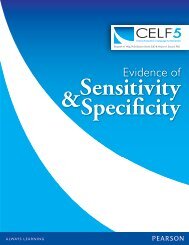
![EBP Brief V1 Issue 1 [8x10].indd - Speech and Language](https://img.yumpu.com/51068713/1/190x238/ebp-brief-v1-issue-1-8x10indd-speech-and-language.jpg?quality=85)

